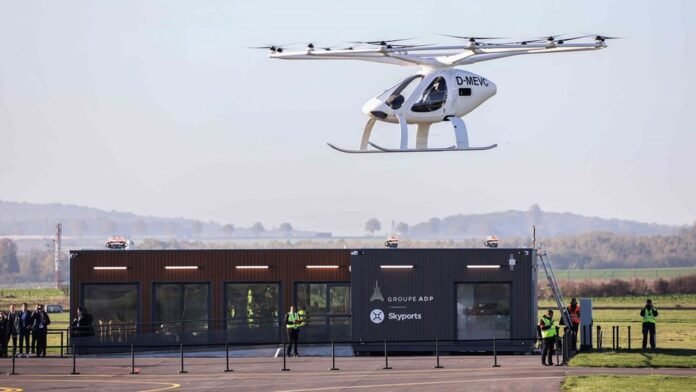Written November 10, 2022, 6:05 p.mUpdated on November 10, 2022, at 18.06.
The horizon is cleared to see flying taxis in the Parisian skies at the Olympic Games in 2024. On Thursday, November 10, the first European vertiport, that is, the terminal for these vehicles halfway between the drone and the helicopter, was inaugurated at the Pontoise airfield (Val-d ‘Oise). It heralds a new form of carbon-free air mobility, which will spread throughout the region in the coming years.
In the morning, the flying taxi (VTOL for electric vehicles with vertical take-off and landing) manufactured by the German Volocopter made its first flight in a conventional environment. During the landing of a small plane, the device successfully took off not far from there. All but one detail in order to obtain the precious certification from the European Aviation Safety Agency (EASA) that is essential to be allowed to fly over the skies of the Ile-de-France region. “You will have the same guarantee of safety as in a commercial aircraft”, assures Jean-Christophe Drai, the France representative of Volocopter, which hopes to get sesame at the beginning of 2024.
Urban integration
This inauguration thus concludes a year of testing at the Cergypontain site. In particular, measuring the noise of the machine – a key point for its social acceptance – which was considered good by the project partners with an emission level of 76 decibels. “This machine emits 4 times less noise than a helicopter”, says Augustin de Romanet, CEO of Aéroports de Paris (ADP), heavily invested in the development of the nascent sector. In fact, in March RATP piloted an in-flight sound impact measurement campaign with the ADP Group, Volocopter, Bruitparif, DGAC (Directorate General of Civil Aviation) and ONERA.
The small building of 115 m2, equipped with a control service, a flight display panel, a work room and a catering area, is ready to receive passengers. “With all the control technologies inside the building, it was a one million euro investment,” says Alex McCord, Vertiport Development Manager at Skyports, who designed and developed it working with the ADP group. The first 5 vertiports will be developed to connect the airports of Le Bourget and Paris-CDG to the quai d’Austerlitz in Paris, as well as from the heliport of Issy-les-Moulineaux to the airfield of Saint-Cyr l’école.
Alternative to VTC
The vehicle, which runs on electricity, can fly up to thirty kilometers. And for the experiment planned for 2024, about ten of this “Velocity” model developed by Volocopter will each provide between 2 and 3 flights per hour. On the price side, the ambition is to adapt to the prices of VTC (transport vehicle with driver), i.e. between 60 and 80 euros to connect Pontoise with, for example, Paris. In another register, the German manufacturer plans to launch another prototype, larger, in 2026. “The Voloregion model will be able to transport 5 people over distances between 100 and 150 km”, specifies Jean-Christophe Drai.
If it is not intended to be operational once the taxis are on the market, the Pontoise vertiport will continue to host the other manufacturers’ tests during the race. With the introduction of the Brazilian Eve Air Mobility, a subsidiary of Embraer, 7 manufacturers have actually started manufacturing the product, such as Volocopter, Airbus, Ascendance Flight Technologies, Lilium, Joby Aviation and Vertical Aerospace.
Discussions with AP-HP
If the ambition is to create some kind of air-VTC service accessible to all by 2030, VTOLs may be asked to perform many other missions. The use for medical purposes is the most advanced today. Indeed, discussions have begun with AP-HP to promote the transport of biological material such as organs, minor injuries or specialized doctors from the Bourget health airport from 2024.
Finally, other applications of the logistics or surveillance type are also being considered. Augustin de Romanet thus suggested that the armies equip themselves with such devices to, for example, monitor military bases.
